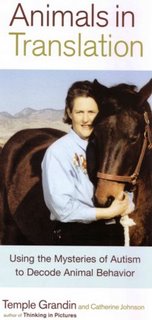 Temple Grandin is an associate professor at Colorado State University and arguably the most accomplished and well-known adult with 'high functioning' autism in the world. Grandin is also a world renowned professional designer of humane livestock facilities.
Temple Grandin is an associate professor at Colorado State University and arguably the most accomplished and well-known adult with 'high functioning' autism in the world. Grandin is also a world renowned professional designer of humane livestock facilities.Grandin became well-known after being described by Oliver Sacks in the title narrative of his book, An Anthropologist On Mars, the title derived from Grandin's description of how she feels around 'neurotypical' people.
In her latest book, Animals in Translation, Grandin attempts to 'use the mysteries of autism to decode animal behaviour.' Some of her ideas:
- redefines consciousness and argues that language is not a requirement for consciousnessScientific American Review:
- categorizes autism as a way station on the road from animals to humans
- explores the "Interpreter" in the normal human brain that filters out detail, creating an unintentional blindness that animals and autistics do not suffer from
- applies the autism theory of "hyper-specificity' to animals, meaning that there is no forest, only trees, trees, and more trees
- argues that the single worst thing you can do to an animal is make it feel afraid
- examines how humans and animals use their emotions, including to predict the future
- compares animals to autistic savants, in fact declaring that animals may be autistic savants, with special forms of genius that normal people cannot see
- explains that most animals have "super-human" skills: animals have animal genius
- reveals the abilities handicapped people, and animals, have that normal people don't
Temple Grandin has been known to crawl through slaughterhouses to get a sense of what the animals there are experiencing. An autistic woman who as a child was recommended for institutionalization, Grandin has managed not only to enter society’s mainstream but ultimately to become prominent in animal research. An associate professor at Colorado State University, she designs facilities used worldwide for humane handling of livestock. She also invented a "hug machine" (based on a cattle-holding chute) that calms autistic children. In Animals in Translation, co-authored with science writer Catherine Johnson, Grandin makes an intriguing argument that, psychologically, animals and autistic people have a great deal in common—and that both have mental abilities typically underestimated by normal people. The book is a valuable, if speculative, contribution to the discussion of both autism and animal intelligence, two subjects on which there is little scientific consensus. Autistics, in Grandin’s view, represent a "way station" between average people, with all their verbal and conceptual abilities, and animals. In touring animal facilities, Grandin often spots details—a rattling chain, say, or a fluttering piece of cloth—that disturb the animals but have been overlooked by the people in charge. She also draws on psychological studies to show how oblivious humans can be to their surroundings. Ordinary humans seem to be less detail-oriented than animals and autistics. Grandin argues that animals have formidable cognitive capabilities, albeit specialized ones, whereas humans are cognitive generalists. Dogs are smell experts, birds are migration specialists, and so on. In her view, some animals have a form of genius—much as autistic savants can perform feats of memory and calculation far beyond the abilities of average people. Some dogs, for example, can predict when their owner is about to have a seizure. Delving into animal emotion, aggression and suffering, Grandin gives tips that may be useful for caretakers of pets and farm animals. She also notes that humans seem to need, and thrive on, the proximity of animals. Indeed, she states provocatively, in the process of becoming human we gave up something primal, and being around animals helps us get a measure of that back.Tags: Autism, Animal Psychology, Animal Rights, Psychology, neurology, Asperger Syndrome.

No comments:
Post a Comment